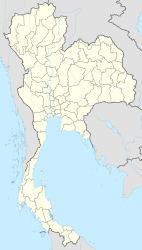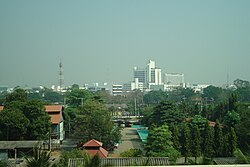Phitsanulok
|
พิษณุโลก Phitsanulok |
||
|---|---|---|
|
|
||
| Coordinates | 16 ° 50 '24 " N , 100 ° 14' 56" E | |
| Symbols | ||
|
||
| Basic data | ||
| Country | Thailand | |
| Phitsanulok | ||
| ISO 3166-2 | TH-65 | |
| surface | 18.3 km² | |
| Residents | 72,601 (2012) | |
| density | 3976 Ew. / km² | |
| Website | www.phitsanulok.go.th (Thai) | |
|
View of Phitsanulok
|
||

Phitsanulok ( Thai : พิษณุโลก , translated " Vishnu's earth"; older inscription Bisnuloka ; earlier also Song Khwae , "two rivers") is the capital of the Thai province of Phitsanulok . Depending on the division, it lies in the lower north or the north central region .
Phitsanulok is one of the historically most important cities and the economic and transport center of this region. In the 15th and 16th centuries, the Uparat (“viceroy”) resided here for a time, and for some time even the king of the Siamese kingdom of Ayutthaya . Today Phitsanulok lies at the intersection of the east-west economic corridor and the north-south corridor defined by the Asian Development Bank as part of the Greater Mekong Subregion Economic Forum. With Naresuan University , Phitsanulok has the largest university in the lower north.
The city of Phitsanulok belongs to the district (Amphoe) Mueang Phitsanulok and has had the administrative status of a "large city" (Thesaban Nakhon) since 1999 . According to official population statistics, it had 72,601 inhabitants in 2012.
geography
Phitsanulok is located about 380 kilometers north of Bangkok , about halfway to Chiang Mai , on the Mae Nam Nan (Nan River) , which flows through the west of the province from north to south.
traffic
Road traffic
The city forms an important transport hub.
- Thailand Route 11 : North-South Connection
- Thailand Route 12 : West-East Connection
- Thailand Route 117 : to Nakhon Sawan
The intersection of National Roads 11 and 12 - 7 kilometers east of Phitsanulok city center - is called the "Indochina Junction" (Si Yaek Indochin) . This is where the north-south and east-west corridors of the Greater Mekong sub-region defined by the Asian Development Bank (ADB) intersect . From here there are long-distance routes to Kunming ( Yunnan Province , China), Kuala Lumpur (Malaysia), Da Nẵng (Vietnam) and Yangon (Myanmar).
Rail transport
Phitsanulok has a station of the Thai state railway on the north runway , the Bangkok with Chiang Mai connects.
Air traffic
- Phitsanulok Airport ( IATA Airport Code: PHS).
Shipping
Shipping hardly plays a role, as the Naresuan Dam hampers transport on Mae Nam Nan .
history
During the 11th century there was a small northern outpost in the area of what is now Phitsanulok, which was named after the Nan and Khwae Noi Song Khwae ("Two Rivers").
At the time of the Sukhothai Kingdom , Phitsanulok was already a larger settlement that was then in the east of the empire. It was surrounded by a rectangular wall, the remains of which can still be seen in some places today. Centrally on the east-west axis of the rectangle was Wat Chedi Yod Thong , initially the main temple of the city. When exactly it was founded is uncertain. However, King Li Thai announced in an inscription that he restored the temple in the 1360s. In 1357 today's main temple of the region, the Wat Phra Sri Rattana Mahathat or Wat Yai, was built . In the 14th and 15th centuries , the old temple Wat Aranyik was built and expanded. When Sukhothai lost its importance and became part of the central Thai kingdom of Ayutthaya in 1438 , Phitsanulok gained weight and became the most important center of the northern provinces (Mueang Nuea) .
Phitsanulok then played an important role in the history of Thailand at times: From 1463 to 1488 Phitsanulok was the residence of King Borommatrailokanat (Trailok) of Ayutthaya . The temples Wat Ratchaburana and Wat Nang Phaya were built under his rule . After the kingdom's residence was moved back to Ayutthaya, Phitsanulok played the role of a training center for the military in the wars against the Burmese. King Naresuan (reigned 1588 to 1605), after whom the city's largest university is named, was born here in 1555. Before he became king, he resided for 17 years as governor and viceroy (Uparat) with responsibility for the northern provinces in Phitsanulok. His father Maha Thammaracha had held this position before him .
In 1756, King Borommakot ordered the further decoration of Wat Yai with mother-of-pearl work on the main gate. In the 19th century, King Mongkut had Wat Ratchaburana generously repaired and expanded.
In 1957 large parts of the old Phitsanulok were destroyed by a conflagration. Some residents therefore still live on houseboats in the Nan River. Fortunately, the highly revered temple complex of Wat Yai was saved. On November 28, 1961, the Naresuan Shrine was opened to the public on the grounds of the king's birthplace, Chandra Palace . The palace itself has been rebuilt from the foundations since the summer of 2008.
Near the old Phitsanulok airport, the College for Education opened on January 25, 1967, at that time a branch of the Srinakharinwirot University , Bangkok, responsible for the north . This was spun off as an independent Naresuan University in 1990 . In 2012 it had 24,226 students, making it the largest university in the lower northern region. Between 1976 and 1985, the Nan Naresuan Dam was built as part of the Phitsanulok Irrigation Project to ensure year-round irrigation of the province's agricultural land and to protect the city from flooding .
military
Phitsanulok is the headquarters of the Third Army Region of the Thai Army , which is responsible for the defense of Northern Thailand.
Attractions
- Wat Phra Si Rattana Mahathat (also Wat Yai , "big temple") - Buddhist temple complex ( Wat ) with a 36 m high, top gilded prang in Khmer style. The viharn with its triple staggered roof has large entrance doors with mother-of-pearl inlays from the 18th century. There is Phra Putthachinnarat , a Sukhothai-style Buddha statue that is highly revered by Buddhists across the country. This statue was the model for the statue of the same name in Wat Benchamabophit , Bangkok.
- Wat Ratchaburana - one of the oldest temples in Phitsanulok, near Wat Yai
- Folklore Museum - views from earlier times, items of everyday life and a complex of several beautiful Thai houses; the museum is privately run (English explanations).
- Wat Chulamani - temple complex south of Phitsanulok, in which King Borommatrailokanat (15th century) was buried.
- Naresuan Shrine - on the floor of the ruined Chandra Palace that is currently being excavated and restored
- Wat Aranyik and Wat Chedi Yot Thong - Buddhist temples from the Sukhothai period (13th-15th centuries)
- Statue of King Naresuan on the Naresuan University campus - the statue was designed by the Fine Arts Department and is approximately twice life size (2.80 m high); it weighs approx. 2000 kg . It shows the king in combat clothing, sitting on the throne, pouring water from a golden container; this symbolizes the newly won independence of the Ayutthaya Empire. The king's face was modeled after the original model by Prof. Silpa Bhirasri . The statue was ceremonially unveiled on August 31, 1993 in the presence of Princess Maha Chakri Sirindhorn .
- The station building in Phitsanulok, which is based on central and southern German half-timbered buildings , was designed and built between 1906 and 1912 by the German architect Karl Döhring .
- Valley of the river Wang Thong (also Khaek) with its waterfalls (see Phitsanulok (province) )
Statue of King Naresuan designed by Silpa Bhirasri
Personalities
- Ekkasit Chaobut (* 1991), football player
- Kritsana Klanklin (* 1984), soccer player
- Sitthichok Mool-on (* 1999), football player
- Panphanpong Pinkong (* 1987), soccer player
Local festivals
- Longboat races are held every year on the Nan River in late September / early October.
particularities
In October 2009 an office of the Thai immigration police was opened in Phitsanulok, which can issue visas for foreign residents and tourists .
The municipal government's waste management is well known in Thailand and even beyond its borders. The first project for separate waste collection started here in 1999, with German help among others. The project was implemented with the help of GTZ . One relied on private companies that collect, separate and recycle the garbage. One example is the Wongphanit chain, which has more than 20 branches in Phitsanulok alone where citizens can sell their waste. The administration also had a mechanical-biological waste treatment plant built. From November 1st to 4th, 2009, an international ESEANET conference on dealing with climate change in health and education took place in Phitsanulok with the support of the Konrad Adenauer Foundation .
literature
- Matthias Kühle-Weidemeier: International Symposium MBT 2005 - International Conference MBA 2005. Cuvillier, Bonn, ISBN 3-86537-665-7 .
- In a factory in Phitsanulok, Thailand, Buddha is copied thousands of times . In: Die Zeit , No. 43/1997, about a visit to the Buddha Image Factory in Phitsanulok
Web links
- City map of Phitsanulok (names in English and Thai) [last accessed on November 11, 2013]
Individual evidence
- ^ Asian Development Bank: Strategy and Action Plan for the Greater Mekong Subregion East-West Economic Corridor. ( Memento of the original from June 6, 2015 in the Internet Archive ) Info: The archive link was inserted automatically and has not yet been checked. Please check the original and archive link according to the instructions and then remove this notice. 2010, pp. 7, 10, 17.
- ↑ Department of Provincial Administration : As of 2012 (in Thai)
- ↑ History of Phitsanulok (Thai)
- ^ AB Griswold: Towards A History Of Sukhothai Art . The Fine Arts Department, Bangkok 1967 (without ISBN), pp. 33, 38
- ↑ Chris Baker , Pasuk Phongpaichit: A History of Thailand. 2nd edition, Cambridge University Press, Cambridge 2009, p. 8.
- ↑ early version of the project planning ( memento of the original from January 9th, 2009 in the Internet Archive ) Info: The archive link was inserted automatically and not yet checked. Please check the original and archive link according to the instructions and then remove this notice. (last accessed on November 2, 2009).
- ↑ Archived copy ( memento of the original from March 20, 2015 in the Internet Archive ) Info: The archive link was inserted automatically and has not yet been checked. Please check the original and archive link according to the instructions and then remove this notice. Newsletter # 9 2009 (last accessed on March 4, 2014).
- ↑ For the results, see Kühle-Weidemeier (2005), pp. 104–105










